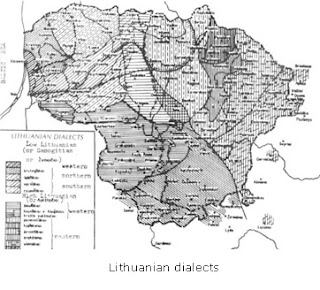Lithuanian, in Lithuanian lietuvių kalba, is a Baltic language belonging to the Balto-Slavic branch of the Indo-European language family.
It is the official language of Lithuania and one of the official languages of the European Union. There are about 2.8 million native Lithuanian speakers in Lithuania and about 200,000 speakers elsewhere.
Lithuanian is closely related to the neighbouring Latvian language. It is written in a Latin script. It is said to be the most conservative of the existing Indo-European languages, retaining features of the Proto-Indo-European language now lost in other languages.
Among Indo-European languages, Lithuanian is conservative in some aspects of its grammar and phonology, retaining archaic features otherwise found only in ancient languages such as Sanskrit (particularly its early form, Vedic Sanskrit) or Ancient Greek. For this reason, it is an important source for the reconstruction of the Proto-Indo-European language despite its late attestation, with the earliest texts dating only to c. 1500.
Lithuanian is one of two living Baltic languages, along with Latvian, and they constitute the eastern branch of Baltic languages family. An earlier Baltic language, Old Prussian, was extinct by the 18th century; the other Western Baltic languages, Curonian and Sudovian, became extinct earlier.
More information: Lituanus
The Simple Words of Catechism, in Lithuanian Katekizmo paprasti žodžiai, by Martynas Mažvydas is the first printed book in the Lithuanian language.
It was printed on 8 January 1547 by Hans Weinreich in Königsberg.
The 79-page book followed the teachings of Martin Luther but reflects both religious and secular needs.
The book included the first Lithuanian-language poem, primer with alphabet, basic catechism, and 11 religious hymns with sheet music.
The book was written in the Samogitian dialect and printed in Gothic (schwabacher) font; Latin dedication and preface are printed in Latin font (antiqua).
Only two copies of the Catechism survived: one is held by the Vilnius University Library and the other by the Nicolaus Copernicus University in Toruń, Poland.
The book does not mention its author or editor. Still, the book was considered the work of Martynas Mažvydas since the 16th century based on a mention by Baltramiejus Vilentas. Any doubts were dispelled when in 1938 Polish linguist Jan Safarewicz discovered an acrostic in the Lithuanian preface of the Catechism. When reading the initial letters of lines 3–19 of the preface, it spells out MARTJNVS MASVJDJVS, or the name Martynas Mažvydas in Latin. About two-thirds of the text in the book was written by Mažvydas. Other authors probably include Abraomas Kulvietis, Stanislovas Rapalionis, Jurgis Zablockis, and possibly rector Friedrich Staphylus.
Martynas Mažvydas followed examples set by other authors. Besides the catechisms of Germans Georg Sauermann (c. 1492-1527) and Jodocus Willich, and Polish Jan Malecki-Sandecki, the booklet was mainly written by referencing to the catechisms and hymnals of Jan Seklucjan, who at that time worked in Königsberg.
More information: The Culture Trip
The book content can be divided into eight parts:
-Title page. It is decorated with a vignette in the Renaissance style.
-Latin dedication. It is a Latin quatrain in elegiac couplet addressed and dedicated to the Grand Duchy of Lithuania.
-Latin preface, or Grace and Peace for the Pastors and Servants of the Lithuanian Churches, was likely written by Mažvydas and Friedrich Staphylus, the rector of the University of Königsberg.
-Lithuanian preface, or The Booklet Speaks to Lietuvininkai and Samogitians, is the first poem in the Lithuanian language.
-Primer, or Cheap and Short Instruction in Reading and Writing, is a four-page introduction to learning to read.
-Catechism. It is the first religious text in the book. It included translations of the Ten Commandments, Apostles' Creed, Lord's Prayer, the Sacraments of Holy Baptism and Holy Communion, and short social and moral instructions.
-End-word. It is short but has two parts. The first part, once again, asks Lithuanians and Samogitians to learn about Jesus and to teach their families as well. The second part is a quatrain addressed to the reader. It proclaims that book are now being printed in his native language and asks to correct any errors that might occurred.
-Hymnal. It includes 11 hymns and 10 sheet music, two hymns used the same sheet. Neither authors nor translators of the hymns are indicated. The main source for these texts was a Polish hymnal by Jan Seklucjan.
More information: Lituanus
no other language in the world has received
such praise as the Lithuanian language.
The garlands of high honour have been taken
to Lithuanian people for inventing, elaborating,
and introducing the most highly developed human speech
with its beautiful and clear phonology.
Moreover, according to comparative philology,
the Lithuanian language is best qualified to represent
the primitive Aryan civilization and culture.
Immanuel Kant


No comments:
Post a Comment